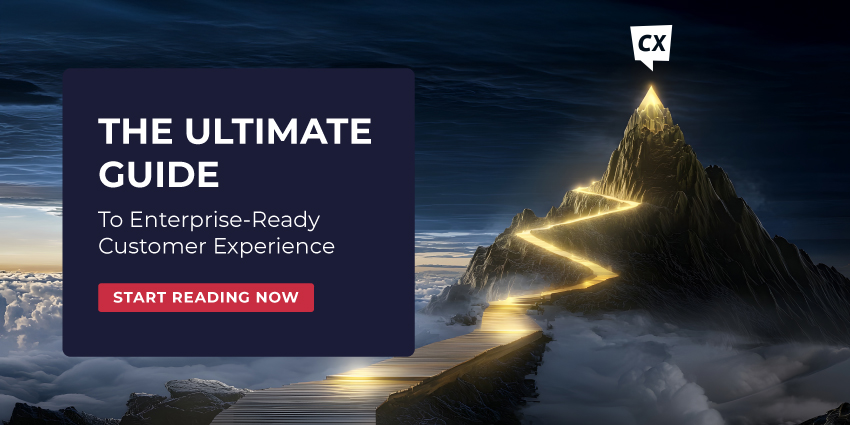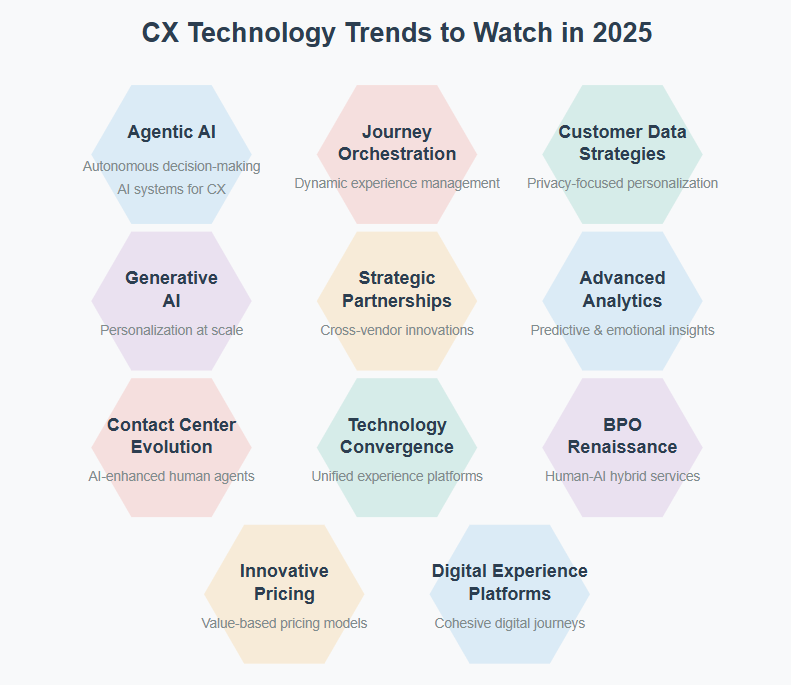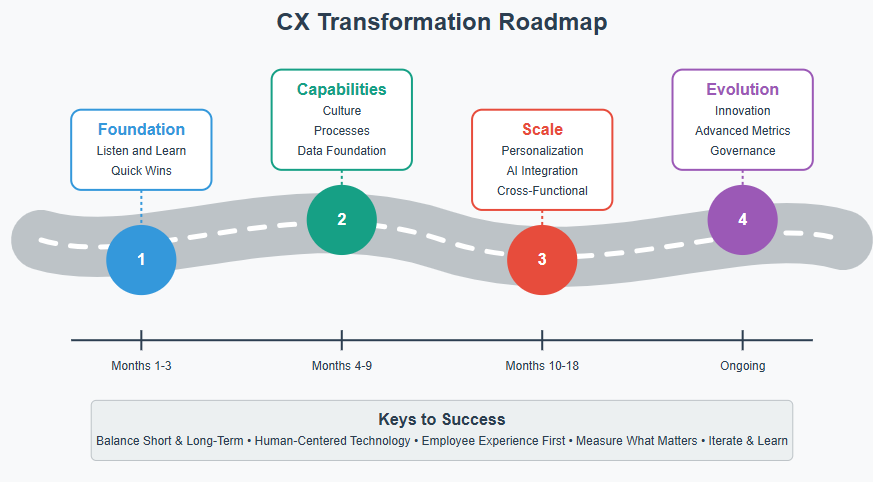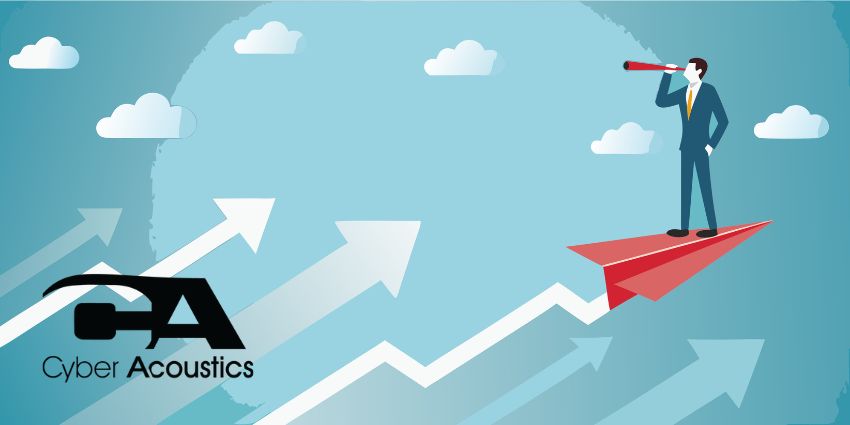CX is customer experience. It encompasses all the interactions customers have with a business throughout their lifecycle, from initial discovery, through to post-purchase support and loyalty.
But how enterprises define CX has changed a lot over the years. It’s not just about making life easier for customers anymore. It’s about building a custom-made, intuitive journey for every buyer. CX defines how people feel about your brand after interacting with it. Not just once, but over time. It’s the sum of every digital click, phone call, chatbot exchange, service ticket, and delivery confirmation.
If those interactions are fast, helpful, and personal, CX becomes an edge. If they’re clunky, slow, or disconnected, CX becomes a problem.
Enterprise teams today think of Customer Experience as more than support, it’s a full-system strategy. One that spans marketing, sales, operations, IT, and product. The customer experience definition isn’t static either, it’s constantly shaped by changing preferences, tech shifts, and how well teams work together internally.
McKinsey says the most successful companies treat CX as a “value engine.” When it’s done right, the numbers back it up. CX leaders see up to 10% more revenue growth and far better retention than those still stuck in siloed service models.
CX isn’t just a metric. It’s the difference between being remembered and being replaced.
Why is CX Important?
For enterprise leaders, the question isn’t just “what is CX?”, it’s why it now belongs in the boardroom. 88% of customers say the experience a company provides is as important as its products or services. Experience is the product now, and it’s competing just as hard as features or pricing.
That’s why Customer Experience (CX) has evolved from a support function into a core business driver. CX matters because:
- Retention is Cheaper than Acquisition: Getting new customers is expensive. Losing them because of broken journeys, long wait times, or impersonal service is avoidable. A 5% improvement in customer retention can drive profit increases of 25–95%, according to Bain & Company.
- Loyalty Drives Advocacy: Great customer experience doesn’t just reduce churn, it creates promoters People don’t just stick with companies that deliver great service, they talk about them. That turns CX into a compound growth strategy.
- Experience Competes Where Price Can’t: In saturated markets, what is CX if not your best shot at standing out? Brands can’t always win on price or speed, but they can win on how they treat people. Enterprise buyers, especially, look for partnership-level experiences, not just transactions.
- CX Fuels Operational Efficiency: When journeys are mapped, data is unified, and support flows are optimized, everything works better. Contact center strain drops. Employee satisfaction goes up. Tools like WEM and AI-assisted service platforms reduce manual load and improve resolution time.
What is CX? The Three Pillars of Exceptional Customer Experience
Every strong Customer Experience (CX) program has three moving parts: people, process, and technology. Not as a framework on a whiteboard, but as the foundation of how modern businesses operate.
Most organizations get stuck because they over-invest in one of these areas and neglect the others. The tech stack gets all the budget. People get stretched thin. Processes grow around outdated tools. Customers feel that imbalance.
For enterprise teams, the goal isn’t to be perfect in all three, but to be intentional about each one. CX Customer Experience isn’t a slogan. It’s a system. And it’s only as strong as the least developed pillar.
It makes sense to start with people, because that’s where experience lives or dies.
Pillar One: People
There’s a difference between responding to customers and taking care of them. The difference usually comes down to who’s on the other side of the interaction, and whether they’ve got what they need to do their job right.
In contact centers, sales teams, field support, and even billing departments, people still shape the most critical moments of the customer experience journey. Tech can assist. Data can inform. But it’s humans who turn frustrated customers into loyal ones. That’s why companies leading in CX aren’t just focused on customers. They’re focused on employees too.
When Microsoft CEO Satya Nadella transformed the company’s approach to CX, he didn’t just talk about customer obsession, he tied executive compensation directly to customer success metrics. This ensured leadership remained focused on customer experience improvements that drove meaningful results.
If internal systems are clunky, if teams are burned out, if there’s no room for autonomy, then it shows. Customers pick up on that. It’s why employee experience and customer experience are so tightly connected, especially in high-scale environments.
This is where Workforce Engagement Management (WEM) enters the picture. It’s not just a back-office tool anymore. WEM platforms help teams:
- Plan smarter shifts
- Track performance without micromanaging
- Coach more effectively
- Keep frontline employees engaged and developing
Increasingly, companies are also experimenting with new ways to expand and scale their teams, working with BPO leaders focused on customer experience, journey optimization, and interactions.
Pillar Two: Processes: Systematizing Consistent Experiences
There’s a moment in most enterprise CX programs where the cracks show, not because of bad tools or unmotivated teams, but because process hasn’t kept up with scale.
That’s when CX becomes inconsistent. One channel works beautifully. Another frustrates customers instantly. Service feels reactive instead of intentional. People start to solve the same problems, in different ways, over and over again.
Strong Customer Experience isn’t just about people doing their best. It’s about systems that support the experience by design.
This is where process comes in, and it has to start with the customer journey.
Mapping the Customer Experience Journey
A well-built customer experience journey map highlights what customers need, what they expect, and where they run into friction. But a static map only gets teams so far. Enterprises need orchestration, real-time actions triggered across systems, not just a PowerPoint slide tracking emotions.
Tools that support customer journey orchestration are becoming essential, especially in large service environments with omnichannel complexity.
Voice of the Customer (VoC): Feedback that Fuels Change
A second piece of the puzzle: feedback. Not the kind that disappears into spreadsheets, but structured, programmatic insight that fuels decision-making.
Voice of the Customer (VoC) programs help teams collect, prioritize, and act on what matters—using surveys, sentiment analysis, live interactions, and behavioral data.
Done right, feedback becomes a loop, not a lagging report. It drives constant tuning of messaging, processes, even product roadmaps.
Closing the Loop with Loyalty
The final piece? Loyalty isn’t just about points programs, it’s about reliability, and how a customer feels after the issue is solved. When processes are clean, proactive, and personalized, customers are more likely to stay, and recommend.
- Discover the top loyalty management software solutions.
CX, at its core, is how repeatable those moments of trust become. Process is what makes them repeatable.
Pillar Three: Technology: Enabling Personalization at Scale
Technology doesn’t fix customer experience on its own. But it makes great experience possible at scale. That’s where most enterprise teams hit the wall. They’ve got the right people. Their processes mostly work. But when the tech is stitched together from too many places, or not designed around the customer experience journey, things fall apart.
In 2025, enterprise buyers expect experiences to be seamless. Channels should talk to each other. Service should feel personalized. Answers should come fast. None of that happens without the right CX technology stack underneath.
Here’s how the best enterprise teams are building for modern CX:
Contact Center and CCaaS Platforms
The frontline of CX often starts in the contact center. CCaaS (Contact Center as a Service) platforms help manage calls, chat, social, and more in one place, with integrated routing, analytics, and agent tools.
CRM and ERP Systems
Customer data lives in CRM. Operational context lives in ERP. Great Customer Experience (CX) happens when these systems speak to each other, so agents and reps can act in real time, without switching tabs.
AI and Conversational Intelligence
Smart chatbots, generative responses, and agent assist tools are reshaping how support works. Conversational AI lets teams automate more without losing the human feel, while also improving consistency across channels.
Business Intelligence, CDPs & Analytics
A modern Customer Experience definition includes data. CDPs (Customer Data Platforms) unify profiles across tools. Business Intelligence (BI) platforms turn that data into insight, so teams can personalize, prioritize, and act.
Feedback & Loyalty Management
Listening matters. So does action. Modern CX stacks include built-in Voice of the Customer (VoC) tools, real-time surveys, and behavior tracking that feed back into journeys and loyalty workflows.
WEM & BPO Solutions
Behind the scenes, Workforce Engagement Management tools and BPO partners help manage scale, whether that’s during peak season or for 24/7 global coverage.
Devices & Endpoints
Customers don’t care about infrastructure, but they notice when call quality drops or a device fails mid-interaction. Modern contact center devices ensure every part of the experience just works.
CPaaS & UCaaS Integrations
APIs and real-time communications infrastructure let businesses build composable, channel-agnostic experiences. CPaaS platforms enable everything from SMS alerts to secure video calls, built into workflows. UCaaS ensures teams can collaborate on CX.
Need help building the ideal CX stack?
What is CX? Contact Center Excellence
The contact center isn’t just one part of the business; it’s often the clearest voice of the brand.
It’s where customers come for answers, resolution, and reassurance. And for most, it’s the most direct, memorable part of the customer experience journey. That makes it one of the most important levers in any CX Customer Experience strategy.
Excellence here doesn’t happen by accident. It comes from investing in both people and tools, then connecting the two in ways that actually make sense for agents and customers alike.
Empowering Agents Through Coaching That Works
Contact center agents with proper coaching deliver consistently better customer experiences. The most effective contact center coaching strategies focus on personalized development plans that balance technical knowledge with emotional intelligence. By implementing regular coaching sessions using real customer interactions, organizations can transform their agents into true CX ambassadors.
Quality Monitoring That Does More Than Score Calls
Understanding what happens during customer interactions is essential for improving your CX strategy. Strategic call monitoring programs help identify both exceptional service moments worth replicating and pain points requiring intervention.
The best programs balance quantitative scoring with qualitative assessment, ensuring you capture both efficiency metrics and emotional connection.
Faster Isn’t Always Better. Smarter Is.
Speed matters. But not if it comes at the cost of real resolution. One of the most challenging aspects of contact center management is balancing speed with quality.
Strategies to reduce average handling time (AHT) without compromising customer satisfaction include implementing intelligent routing, providing agents with comprehensive knowledge bases, and using AI-powered assistance tools. The goal isn’t simply faster interactions but more effective ones that resolve customer issues completely on the first contact.
Smarter Staffing with WEM Tech
Too many or too few agents, it hurts either way. That’s why modern workforce management platforms are leaning hard into AI and forecasting. They help teams align resources with real-world demand, reduce idle time, and even offer self-service scheduling to keep agents engaged.
What is CX? Measuring Customer Experience
It’s one thing to promise great experience. It’s another to prove it.
That’s why measurement matters. In modern enterprises, CX customer experience isn’t just about good vibes or anecdotal wins. It’s a performance metric. It’s a boardroom conversation. And increasingly, it’s tied directly to growth targets, retention goals, and operational KPIs.
So if someone asks, “what is CX measurement really about?” the answer is: alignment. Measuring CX means making sure what customers actually experience matches what your business intends to deliver. Here’s where most enterprise teams start:
- Net Promoter Score (NPS): Still a staple in enterprise CX. NPS tracks how likely customers are to recommend your brand. Simple, scalable, and a decent signal of long-term loyalty, if used with context.
- Customer Satisfaction (CSAT): Measures how satisfied someone is with a specific interaction or moment in their journey. Quick to collect, especially post-service.
- Customer Effort Score (CES): This one’s gaining ground. CES asks: how easy was it to get what you needed? It’s a strong predictor of future behavior, especially for support or service-heavy brands.
- Churn Rate / Retention Rate: You can’t define CX without talking about outcomes. Churn and retention are blunt but valuable indicators of how well experience is working over time.
Beyond the Score: What Leading Teams Are Doing Differently
Data is useful. But insights move the needle. The most advanced Customer Experience teams now go further:
- Journey Analytics: Mapping behavior across touchpoints, not just post-event surveys
- Real-Time Feedback Tools: Embedded surveys, in-app prompts, and emotion detection
- Voice of the Customer (VoC) Programs: Structured systems to capture, route, and act on feedback
Increasingly, that feedback isn’t just for CX teams, it’s looped into product decisions, marketing campaigns, and even sales strategy. McKinsey puts it clearly: companies that embed Customer Experience metrics across the org grow revenue faster, serve customers more efficiently, and keep them around longer.
CX Technology Innovation: Top Trends to Watch
The technology powering CX Customer Experience isn’t just evolving, it’s accelerating. Fast.
In 2025, companies aren’t just shopping for platforms. They’re rethinking how entire customer journeys are built. The old boundaries between sales, service, and support are collapsing. The tech stacks once held together with duct tape and middleware are being replaced by smarter systems that actually talk to each other.
Based on ongoing market research, here are the most transformative technology trends shaping Customer Experience (CX) right now, and where enterprise leaders should focus next.
Agentic AI: Beyond Simple Automation
Basic chatbots are done. What’s next is agentic AI, autonomous systems that can handle real tasks without constant input.
These AI agents are scheduling appointments, initiating refunds, solving technical issues, and making proactive decisions based on real-time context. They’re capable of managing entire journeys from start to finish, often without human escalation.
Generative AI: Personalization at Scale
Generative AI has moved beyond experimental use cases to become a core component of production CX systems. Used well, it can craft service responses that sound human, not robotic. It can generate product recommendations, dynamic content, and personalized replies, all based on real-time customer context and historical data.
The real unlock? Combining generative models with your CDP or BI platform, so every response is grounded in who the customer actually is, not just what they typed.
Customer Data Strategies
As privacy regulations tighten, brands are shifting from tracking to asking. That’s where zero-party data comes in, info customers choose to share, often in exchange for better service, smarter recommendations, or more relevant offers.
Combine that with clean first-party data collected across owned channels with a Customer Data platform, and enterprises get the backbone of a compliant, high-trust personalization strategy.
Strategic Partnerships & Co-Innovation
No single vendor can build the full experience anymore. That’s why co-innovation is becoming more valuable. CPaaS vendors are teaming up with a DXP to offer integrated comms inside personalized web journeys.
Or a contact center platforms are natively linking with loyalty engines and UCaaS solutions. The best enterprise CX teams are paying close attention to these partnerships, not just buying products, but buying into ecosystems.
Journey Orchestration: Where the Real Battle Is
What is CX if not the sum of every interaction, and how smoothly they connect?
Modern journey orchestration platforms don’t just map stages on a whiteboard. They recognize real-time intent, trigger dynamic experiences, and guide customers toward ideal outcomes automatically.
This leads to fewer dead ends, fewer “please hold” moments, and more fluid, intuitive journeys, whether someone’s shopping, renewing, or asking for help.
Advanced Analytics & Reporting
It’s not enough to track NPS or CSAT. Leading CX teams are using AI-driven analytics to measure emotion, effort, and future value, not just what already happened.
Modern dashboards now surface predictive insights: who’s likely to churn, which experiences drive revenue, which channels increase lifetime value.
The Evolving Contact Center Landscape
Forget the call center clichés. Today’s contact centers run on real-time emotion detection, predictive coaching, and AI-assisted triage. Agents aren’t being replaced, they’re being amplified. The tech gives them better timing, context, and tools to resolve complex issues quickly, while still keeping the interaction personal.
CPaaS and Tech Convergence
CPaaS platforms have moved beyond basic SMS and voice APIs. Now they power multichannel orchestration, video, chat, messaging, voice, embedded directly inside customer journeys. The customer doesn’t jump apps. The communication meets them where they are.
The boundaries between traditional CX technology categories: CCaaS, CRM, CPaaS, DXP, are rapidly blurring too. This convergence is creating unified platforms that manage the entire customer lifecycle across all touchpoints. Organizations that understand this trend are focusing less on specific product categories and more on creating cohesive technology ecosystems that deliver seamless experiences.
The BPO Renaissance
Business Process Outsourcing (BPO) providers have reinvented themselves as strategic CX partners, offering specialized expertise in implementing and operating complex technology stacks. Modern BPOs combine human agents with AI systems to deliver hybrid service models that scale efficiently while maintaining high-quality experiences. This evolution has made specialized BPO partnerships a critical component of many organizations’ CX technology strategies.
Innovative Pricing Models
Software pricing is catching up to business reality. Instead of paying for licenses you’ll never fully use, more vendors now offer usage-based or value-based pricing. You pay for outcomes, not just access. It’s a shift that’s lowering the barrier to entry for high-quality CX tech, and giving mid-market players a real shot at competing.
So what is CX in 2025?
It’s not a department, or a platform. It’s a connected, adaptive system where tech empowers people, not replaces them, and where experience is designed with the customer, not just around them.
The future of CX Customer Experience is agile, composable, and deeply human, even when it’s driven by machines.
Building Your CX Transformation Roadmap: A Strategic Framework for Success
Great Customer Experience (CX) doesn’t come from chasing tools. It comes from knowing why those tools exist in the first place.
Too many CX programs start in the middle, buying platforms, hiring consultants, implementing tech, before answering a more fundamental question: what kind of experience are we trying to deliver?
Leading organizations build a CX roadmap that aligns with customer expectations, business goals, and internal realities. That journey usually unfolds in four phases, each with its own priorities, challenges, and turning points.
Phase 1: Foundation Building (Months 1-3)
Every effective customer experience journey starts with a clear-eyed look at what’s working, what’s not, and where the biggest gaps live.
Listen and Learn
Start with what customers are already telling you, through:
- Voice of Customer Assessment: Gather feedback through surveys, interviews, and focus groups to identify pain points and opportunities. Don’t just collect data, actively listen for emotional themes that quantitative metrics might miss.
- Journey Mapping Workshops: Bring cross-functional teams together to document the current state of key customer journeys. Focus on moments that matter most to customers, not just internal process steps.
- Experience Audits: Objectively evaluate your touchpoints through the customer’s eyes. Try becoming a customer of your own organization to identify friction points firsthand.
Loop in the Frontline
No one knows your customers better than the people who talk to them every day. Sales reps, service agents, onboarding teams, they hear the pain points unfiltered.
Build mechanisms to collect their input regularly. This doesn’t need to be fancy. Roundtables, anonymous feedback forms, even open Slack threads can surface useful patterns.
Focus on internal alignment. That means getting execs, functional leaders, and delivery teams on the same page about what CX means for your business, not just in theory, but in practice.
Do you care more about loyalty or acquisition? Do you compete on speed, personalization, or depth of service? What are the trade-offs?
Quick Wins for Early Momentum
Identify and implement high-impact, low-effort improvements that demonstrate value quickly:
- Fix Obvious Pain Points: Address the “low-hanging fruit” issues that repeatedly frustrate customers but can be resolved with minimal investment or complexity.
- Empower Frontline Staff: Give customer-facing employees more authority to resolve issues on the spot. This both improves customer outcomes and builds employee engagement.
- Simplify Communication: Eliminate jargon, clarify policies, and simplify customer communications across channels to reduce confusion and effort.
Phase 2: Building Capabilities (Months 4-9)
After aligning on vision and uncovering the gaps, the next step is building the infrastructure that can carry that vision forward. This isn’t just about tech. It’s about people, processes, and platforms that actually make the customer experience journey better.
People: Cultivate a Customer-Centric Culture
Your people strategy forms the foundation of sustainable CX excellence:
- Leadership Alignment: Ensure executives model customer-centric behaviors and tie compensation to CX outcomes. When leaders consistently demonstrate that customer experience matters, the organization follows.
- Skill Building: Develop training programs that balance technical capabilities with emotional intelligence. Remember that empathy is as important as efficiency in creating memorable experiences.
- Recognition Programs: Celebrate and reward behaviors that exemplify your CX values. Share stories of exceptional customer experiences broadly to reinforce what “good” looks like.
Operational Excellence: Design for Consistency
Create processes that deliver reliable, frictionless experiences:
- Service Standards: Define clear standards for each stage of the customer journey, establishing both what should happen and how it should feel.
- Process Reengineering: Redesign key processes from the customer’s perspective, eliminating unnecessary steps and handoffs that create friction.
- Quality Assurance Framework: Implement measurement systems that evaluate experience quality beyond efficiency metrics, considering both operational performance and emotional connection.
Unify Your Data and Insights
Build the technical foundation for personalized experiences:
- Customer Data Platform: Implement a unified customer data solution that creates a single source of truth across touchpoints.
- Journey Analytics: Deploy tools that track and analyze customer behavior across channels to identify patterns, friction points, and opportunities.
- Voice of Customer Platform: Establish systematic collection and analysis of customer feedback with capabilities to close the loop on individual issues.
Phase 3: Scale and Optimization (Months 10–18)
Once the foundations are in place, it’s time to build momentum. This is where teams go from fixing isolated issues to designing experiences that are personalized, predictive, and consistent across the entire customer experience journey.
Personalization at Scale
Move beyond one-size-fits-all experiences:
- Customer Segmentation: Develop nuanced segments based on needs, behaviors, and value to enable tailored experiences.
- Next-Best-Action Capabilities: Implement AI systems that recommend personalized next steps based on customer context and history.
- Trigger-Based Journeys: Create automated experiences that respond to specific customer behaviors or life events with relevant, timely interactions.
Advanced Technology Implementation
Leverage innovative technologies to enhance human capabilities:
- AI-Powered Assistance: Deploy AI tools that augment human abilities rather than replace them, such as agent assistance solutions that provide real-time recommendations.
- Predictive Experience Management: Implement systems that identify potential issues before they impact customers, enabling proactive intervention.
- Self-Service Optimization: Enhance digital self-service capabilities with natural language understanding and guided experiences that solve complex problems without human intervention.
Cross-Functional Integration
Break down organizational silos that fragment the customer experience:
- Journey Ownership: Assign executive sponsors to key customer journeys who have authority across traditional departmental boundaries.
- Integrated Metrics: Align success measures across departments to avoid optimization of individual touchpoints at the expense of the overall journey.
- Collaborative Workspace: Create physical or digital spaces where cross-functional teams can collaborate on customer experience initiatives.
Phase 4: Continuous Evolution (Ongoing)
By this point, the groundwork is built. The tech is live. The journeys are mapped. But what is CX if not constantly evolving?
Customer needs shift. Competitive landscapes change. Platforms evolve or disappear. What separates mature CX organizations isn’t that they finish the roadmap, it’s that they never stop iterating on it.
Innovation Pipeline
Establish mechanisms to continuously reimagine the customer experience:
- Customer Co-Creation: Involve customers directly in designing new experiences through advisory boards, design thinking workshops, and beta testing programs.
- Competitive Intelligence: Systematically evaluate competitors and cross-industry leaders to identify emerging experience trends and expectations.
- Innovation Sprints: Hold regular time-boxed initiatives focused on solving specific customer challenges or enhancing particular journeys.
Advanced Measurement
Move beyond traditional metrics to truly understand experience impact:
- Economic Modeling: Quantify the financial impact of experience improvements through sophisticated ROI analysis.
- Predictive Indicators: Identify leading indicators that predict future loyalty and spending behavior based on experience patterns.
- Emotional Analytics: Measure not just what customers do but how they feel, using sentiment analysis, emotion detection, and relationship strength indicators.
Governance and Sustainability
Ensure long-term focus and accountability:
- Executive Steering Committee: Establish senior-level governance that regularly reviews experience performance and allocation of resources.
- CX Operating Rhythm: Create a structured cadence of reviews, planning sessions, and improvement initiatives that maintains focus despite changing business conditions.
- Knowledge Management: Implement systems to capture and share CX insights, preventing the loss of institutional knowledge as teams change.
What is CX? Keys to Success
Throughout your transformation journey, keep these principles in mind:
- Balance Short and Long-Term: Maintain momentum with quick wins while building the foundational capabilities required for sustainable excellence.
- Human-Centered Technology: Select and implement technology that enhances human connections rather than replacing them, recognizing that emotional engagement often drives loyalty more than efficiency.
- Employee Experience First: Recognize that exceptional customer experiences begin with engaged employees who feel valued, empowered, and equipped to succeed.
- Measure What Matters: Look beyond vanity metrics to understand the experiences that truly drive customer loyalty and business outcomes.
- Iterate and Learn: Approach transformation as a continuous journey of experimentation and learning rather than a one-time project with a fixed endpoint.
By following this roadmap, you can create experiences that don’t just satisfy customers but inspire genuine loyalty and advocacy, turning customer experience into your most sustainable competitive advantage.
Need more help? Join our CX Community.
The Heart of Tomorrow’s Customer Experience
I’ve spent nearly two decades watching customer experience evolve from a back-office function to a boardroom priority. Through all the technological revolutions, from the first clunky IVRs to today’s sophisticated AI agents, one truth remains constant: genuine human connection is irreplaceable.
Despite all our AI innovations and personalization engines, customers still crave the fundamentally human experiences of being heard, understood, and valued. The organizations that thrive will be those that use technology not to replace these human moments but to enhance them—freeing their people to focus on connections that truly matter while automating the routine.
I’ve seen firsthand how organizations that approach CX as a fundamental business strategy rather than a departmental initiative create magic. When customer experience principles guide decisions across product development, marketing, operations, and service, the result isn’t just satisfied customers, it’s passionate advocates who drive growth through their enthusiasm and loyalty.
My colleague who leads CX for a global technology firm put it perfectly: “Customer experience isn’t something we do, It’s everything we do.” This mindset shift from viewing CX as a function to seeing it as the essence of your brand is what separates category leaders from the rest of the pack.
The journey to exceptional customer experience isn’t linear or finite, it’s a continuous cycle of listening, learning, and evolving.
Ready to Take the Next Step?
Need more guidance? CX Today is here to help:
- Join the Community: Be part of a community that shapes the future of CX. Join thousands of like-minded professionals who share your passion for exceptional customer experiences.
- Stay informed: Check out the CX Noticeboard: your hub for CX community happenings. Discover events, discussions, and opportunities where fellow CX enthusiasts gather to exchange game-changing ideas.
- Check out the leaders: Meet the CX community’s brightest minds. Connect with innovators whose insights are elevating the entire CX profession and inspiring our community’s collective growth.
- Visit the latest events: Where our CX community meets face-to-face. Discover the gatherings where relationships are formed, knowledge is shared, and the CX community comes together to innovate.
- Plan your next purchase: Visit the CX Today Marketplace for a behind-the-scenes insight into the leaders innovating across categories.
The journey to incredible customer experience starts here. Get ready to take the first step.









